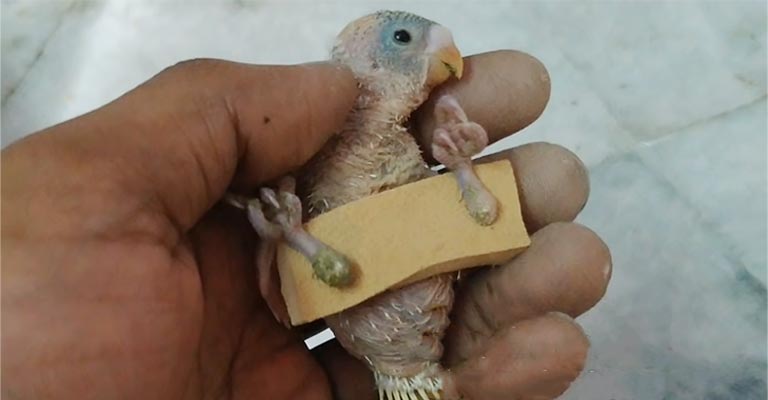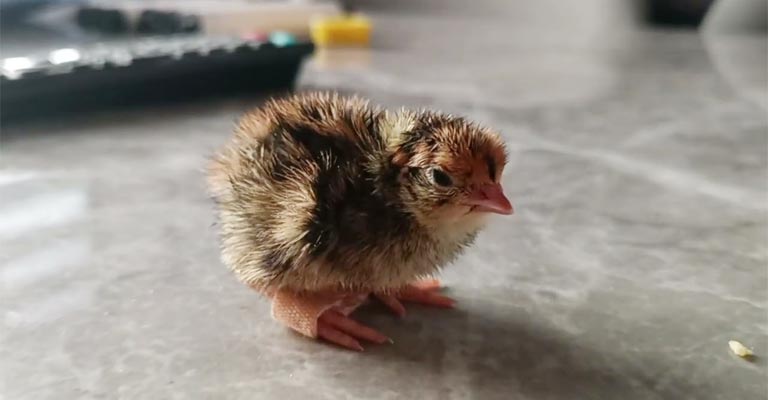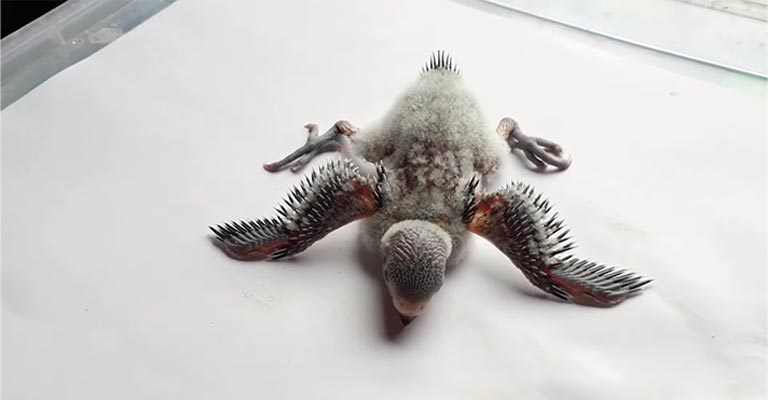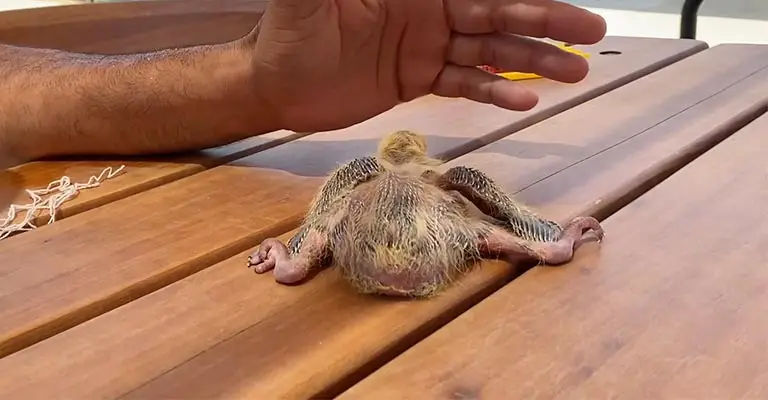Splayed legs, a condition where a bird’s legs appear to be misaligned, can be a distressing sight for bird owners. Whether you’re raising poultry, parrots, or other avian companions, it’s essential to address this issue promptly to ensure the bird’s well-being.
However, with the right knowledge and care, it is possible to correct splayed legs and help your feathered friend lead a normal and healthy life.
In this comprehensive guide, we will walk you through the steps and techniques for fixing splayed legs in birds.
From assessing the severity of the condition to implementing practical solutions and supportive measures, we’ll provide you with the tools to understand and address splayed legs, giving your bird the opportunity to stand tall and regain its mobility.
Let’s embark on this journey together, ensuring a happier, healthier future for your avian companion.

How to Fix Splayed Legs in Birds?
Splayed legs are easy to identify by observing the affected bird’s leg positioning. The most common signs include outward or sideways leg position.
The legs of the bird are positioned away from its body, making it challenging for the bird to stand or walk.
The bird may struggle to stand or balance on its legs. It may often sit or lie on its belly. Birds with splayed legs may exhibit poor coordination and balance when they attempt to move.
The affected bird may not be able to reach food or water easily, leading to reduced activity and potential weight loss.
Early Intervention
The key to successfully fixing splayed legs in birds is early intervention. The younger the bird, the better the chances of recovery. As soon as you notice splayed legs in a chick, take action. Delay can make correction more challenging.
Isolate the bird with splayed legs from the rest of the flock or cage. This will prevent further complications, as other birds might accidentally injure the affected one.
Create a Supportive Environment

Provide the affected bird with a safe and comfortable environment. Use a soft, non-slippery bedding material to prevent any leg injuries. Make sure the temperature is appropriate for the bird’s age and breed.
Leg Realigning
There are various methods to realign the bird’s legs, and the choice of method may depend on the severity of the condition. Here are some common techniques:
Leg Splints
For mild cases, you can create leg splints using soft materials like medical tape, small straws, or band-aids. Gently bind the legs in the correct position, making sure they are not too tight. Check the alignment regularly and adjust the splints as needed.
Hobbles
Hobbles are small bands or loops that connect the bird’s legs, encouraging them to stay in the correct position. Hobbles are especially useful for medium to severe cases.
Shoe Method
This technique involves creating small shoes or boots to guide the legs into the correct alignment. These shoes are usually made from materials like cardboard or foam. The bird’s legs are placed inside the shoes, and the shoes are secured around the legs.
Monitor Progress

Regularly check the bird’s progress and make adjustments to the realignment method as needed. Ensure that the legs are gradually returning to their normal position.
A balanced diet is essential for the bird’s recovery. Provide high-quality bird feed and supplements if necessary to support bone and muscle development.
Physical Therapy
Encourage the bird to exercise its legs. Gently place the bird on a soft surface and allow it to push against your fingers or a solid object. Gradually increase the duration of these exercises as the bird gets stronger.
Long-Term Care
Recovery from splayed legs is a gradual process. Even after the legs appear to be correctly aligned, it’s essential to continue monitoring the bird’s progress and ensuring it maintains proper leg strength and coordination.
When to Seek Professional Help?
In some cases, despite your best efforts, the bird’s legs may not respond to correction or may get worse.
If you’re not seeing any improvement after a week of intervention, or if the condition is getting worse, it’s advisable to seek the assistance of a veterinarian or avian specialist. They can provide further guidance, potential medical treatments, or surgical options if necessary.
Can Birds Survive with Splayed Legs?

While splayed legs can be a serious issue, the outcome largely depends on various factors, including the bird’s age, the severity of the condition, and the level of care and intervention provided.
Let’s explore whether birds can survive with splayed legs and what you can do to support them.
Survival and Splayed Legs
The ability of a bird to survive with splayed legs depends on several factors:
Age
The age of the bird plays a crucial role in determining its chances of survival. Splayed legs are more manageable and treatable in young birds, especially chicks.
The younger the bird, the better the prospects for recovery. Birds that develop splayed legs as adults may face more significant challenges.
Severity of the Condition
The severity of splayed legs varies. In mild cases, where the legs are only slightly misaligned, birds may still be able to get around, albeit with some difficulty.
In severe cases, where the legs are splayed out wide, the bird may struggle to move, perch, or even reach food and water.
Timely Intervention
Early intervention is critical in improving the chances of survival. The sooner you address splayed legs, the better the outcome. Prompt action can prevent secondary issues like injury, dehydration, and malnutrition.
Challenges of Survival with Splayed Legs
Birds with splayed legs face several challenges that can impact their survival:
Mobility
Splayed legs significantly impair a bird’s ability to move. They may be unable to walk, hop, or perch, which makes accessing food and water a constant struggle. This mobility issue can lead to malnutrition and dehydration.
Vulnerability to Injuries
Birds with splayed legs are more susceptible to injuries. Their legs are often splayed out, which can lead to cuts, abrasions, and pressure sores. Additionally, they may get trampled or bullied by other birds in a flock, leading to further injuries.
Social Isolation
Birds are social creatures and thrive on interaction with others of their kind. Birds with splayed legs may become socially isolated if they can’t keep up with their flock or interact normally.
The quality of life for a bird with splayed legs can be significantly compromised. They may face daily challenges and discomfort, which can affect their overall well-being.
Supporting Birds with Splayed Legs
If you have a bird with splayed legs, there are steps you can take to support their survival and improve their quality of life:
Isolate and Protect
Isolate the bird with splayed legs from the rest of the flock or cage to prevent further injuries or bullying. Provide a safe and comfortable environment with appropriate bedding. Implement corrective measures to realign the bird’s legs.
Techniques include leg splints, hobbles, or the shoe method, depending on the severity of the condition. Early intervention is crucial for these methods to be effective.
Monitoring
Regularly monitor the bird’s progress and adjust the corrective measures as needed. Ensure that the legs are gradually returning to their normal position.
Provide a well-balanced diet to support the bird’s overall health and development. High-quality bird feed and supplements, if recommended by a veterinarian, can be beneficial.
Physical Therapy
Encourage the bird to exercise its legs. Gentle leg exercises can help strengthen the muscles and improve coordination.
Spend time with the bird to provide social interaction and mental stimulation. Even if the bird cannot join the flock, your companionship can make a significant difference in its quality of life.
Veterinary Care
If the condition does not improve with your efforts, or if it worsens, consult a veterinarian or avian specialist for professional guidance. They may recommend additional treatments, such as surgery or medications, depending on the bird’s specific case.
When to Make Difficult Decisions?
In some cases, despite your best efforts and professional guidance, a bird with splayed legs may continue to suffer, and their quality of life may be severely compromised.
In such situations, it’s essential to consider the bird’s welfare and make a humane decision. This could involve providing palliative care, humane euthanasia, or consulting with a veterinarian to explore the most compassionate course of action.
FAQs
Can adult birds develop splayed legs, or is it primarily a condition in chicks?
While splayed legs are more commonly observed in young chicks, adult birds can develop this condition as well. However, it is less common in adult birds and may have different underlying causes compared to chicks.
Can splayed legs be prevented in newly hatched chicks?
Yes, splayed legs can often be prevented in newly hatched chicks with proper incubation and care. Maintaining appropriate humidity levels, avoiding temperature fluctuations, and ensuring the correct positioning of eggs during incubation are essential preventive measures.
Are there any specific breeds or species of birds more prone to splayed legs?
Splayed legs can affect various species of birds, but it may be more prevalent in some breeds due to genetic factors. For example, certain poultry breeds may have a higher likelihood of splayed legs.
Can splayed legs be hereditary, and should I avoid breeding birds with splayed legs?
Splayed legs can have genetic factors, and if a bird has splayed legs, it’s generally advisable to avoid breeding it to prevent passing on the condition to offspring. Instead, focus on breeding birds with healthy leg structures.
What is the long-term prognosis for a bird with splayed legs, and can they lead a normal life?
The long-term prognosis for a bird with splayed legs depends on various factors, including the bird’s age, the severity of the condition, and the quality of care and intervention provided. With early intervention and effective corrective measures, many birds can lead relatively normal lives.
Conclusion
Splayed legs in birds may initially seem daunting, but with the right approach and commitment, you can make a significant difference in your feathered friend’s life.
By assessing the condition early, providing proper care, and implementing corrective measures, you can help your bird regain its strength, balance, and mobility.
Regular monitoring, gentle physical therapy, and dedicated attention are key to achieving positive outcomes. Your efforts can lead to a remarkable transformation in your bird’s quality of life.
We hope this guide has empowered you with the knowledge and confidence to address splayed legs in birds effectively.
By taking proactive steps and providing the care your bird needs, you can look forward to witnessing its progress and enjoying a healthier and happier bond with your avian companion. Together, you and your bird can overcome this challenge and embark on a brighter future.